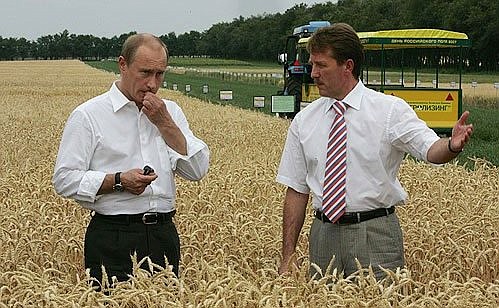
Do We Face A Global Food Disaster?
By F. William Engdahl
31 May 2019
Image License: Creative Commons Attribution 4.0 International https://bit.ly/2MpcLFX
No, this is not at all an endorsement of the apocalyptic scenarios of AOC or that famous young Swedish climate expert, Greta. It is, however, a look at unusual weather disasters in several key growing regions from the USA to Australia, the Philippines and beyond that could dramatically affect food availability and prices in the coming year. That in turn could have major political implications depending on how the rest of the growing season develops .
USA Midwest Waterlogged
According to the latest May 20 report of the National Agricultural Statistics Service (NASS) of the US Department of Agriculture, corn and soybean crops are well behind the planting growth levels normal this time of the planting season. They report that only 49% of all planned corn acreage in the US has been planted compared with 78% at this time a year ago. Of that only 19% has yet emerged from the ground compared to 47% in May 2018. In terms of soybeans, barely 19% of crops have yet been planted compared with 53% a year before. Rice acreage planted is down to 73% compared to 92% a year ago in the six US rice-growing states. Of course, should weather dramatically improve the final harvest numbers could improve. It is simply too early to predict.
The USA is by a wide margin the world largest soybean producer with 34 percent of the world’s soybean production and 42% of world exports prior to the China trade battles. The US is also the world largest corn or maize producer, almost double China, the number two. A serious harvest failure in these two crops could significantly affect world food prices, leaving aside the unfortunate fact that almost all US soybeans and corn are GMO crops. They are mainly used in animal feed.
A major factor in the disruption of the US Midwest growing season is the fact that the past 12 months have seen the greatest precipitation levels since the US Government began keeping statistics in 1895, according to the US NOAA National Centers for Environmental Information. Record snowfall followed by abnormally heavy rains are the reason.
Noteworthy is the fact that a strong Pacific El Niño was in play during 2015-16 and a new El Niño has been confirmed this past winter, somewhat earlier than normal. Precisely how that affected the current weather is not yet clear. El Niño is the periodic warming of the equatorial eastern and central Pacific Ocean.
Connected with solar activity, not manmade factors, it can shift global weather patterns over a period of months, bringing the possibility of more warm, cold, wet or dry weather in parts of the world. They occur in cycles every several years, usually every two to seven years, and it is notable that there is a confirmed, if relatively weak El Nino which is expected to reach peak this month of May. The NOAA in April estimated that the current El Niño conditions are likely to continue through the Northern Hemisphere for spring 2019 (~80% chance) and summer (~60% chance).
Australia and Philippines Severe Drought
While the Midwest USA farm-belt is waterlogged, other regions of the globe suffer drought, most notably, Australia, a major grain producer. For the first time since 2007 Australia is being forced to import wheat, mainly from Canada. Last year drought caused a 20% crop harvest reduction. The Government has issued a bulk import permit to deal with the situation. Current wheat harvest estimates are for only 16 million metric tons, half of what it was two seasons ago. Australia is in recent years the number five world wheat export nation.
Adding to the shortfall of grains, The Philippines is experiencing a major drought since February 2018, which is devastating the current rice crop. Although the country is not one of the world top rice producers—India, Thailand, Vietnam and Pakistan comprise a total of some 70% all rice export—it has significant political impact on the troubled country.
Another country being hit by severe drought is North Korea. There rainfall so far this year is lowest since 1982. State media reports that a “severe drought has been lingering in all parts” of the country. The average precipitation since January is only 42.3% of the average annual precipitation of 5 inches. This comes as the country experiences significant food shortages. While data is likely politicized, effect of international sanctions do not help.
While these significant shortfalls are still not grounds for declaring global emergency, notably they take place at the same time the Peoples’ Republic of China is in the midst of the worst infestation of deadly African Swine Fever across the entire China pig population. USDA estimates that as many as 200 million pigs must be slaughtered this year if the contagion is to be at all contained. China is the world’s largest pig producer by far with some 700 million. As if this were not bad enough, the country is being hit by a plague of Fall Armyworms which could devastate crops such as corn or soybeans across China.
This all does not take into account the various warzones around the world from Yemen to Syria to the Congo where agriculture production has been devastated as a casualty of war.
Russia as New Grain Power?
These current crop difficulties or possible major harvest shortfalls could be a major advantage to Russia, the country which, since imposition of US and EU sanctions in 2014, has emerged in the past three years to become the world’s largest wheat exporter, far surpassing both Canada and the United States. This current 2019/2020 harvest year, Russia is estimated to export a record 49.4 million tons of wheat, some 10% above a year ago. Last year Russia accounted for 21% of total world wheat exports compared with around 14% for the USA and about the same for Canada.
Western sanctions on Russia have had the interesting effect of forcing the government to take measures to become self-sufficient in food production. The Government banned GMO plantings or imports in 2016, and enjoys some of the most productive black earth soils on the planet. At least in the short term, Russia stands well suited to step in to address the various harvest shortfalls in the world grain markets.
While it is unlikely that it will be asked to sell grain to the US, were that to happen, it would be a major historic irony. During the Soviet harvest failures of the early 1970’s it was Secretary of State Henry Kissinger who orchestrated, with the complicity of Cargill and the grain cartel, sale of tons of grain to the USSR at enormously inflated prices in what came to be called the Great Grain Robbery, sending grain prices in the Chicago commodity exchanges to 125 year highs. Combined with the 1973-74 OPEC 400% oil price shock, one in which the sneaky diplomacy of the same Kissinger played a central role, food and oil were responsible for the great inflation of the 1970’s, not the wage demands of American or European workers as we were told.
F. William Engdahl is strategic risk consultant and lecturer, he holds a degree in politics from Princeton University and is a best-selling author on oil and geopolitics, exclusively for the online magazine “New Eastern Outlook”
